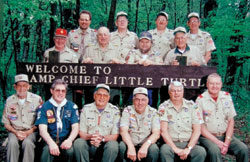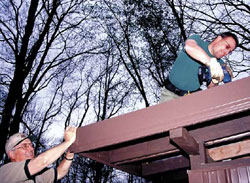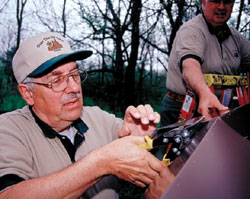Labors of Love
By Robert Peterson
Photographs by: John R. Fulton, Jr.
Older Scouters provide volunteer maintenance and building work at council Scout camps.
 Members of the Anthony Wayne Area Council 's Over the Hill Gang pause during their labors for a group portrait at Camp Chief Little Turtle. (Front) Jimmie Allman, Lowell Tillman, Joe Kelsey, Dave Ramp, Gene Barrett, Kay Houtz; (middle) Bob Lancaster, Jack Zeiger, Bill Zion, Keith Kelsey; (top) Jay Herbrand, Ray Hill, Jon Geraghty [camp ranger], Glenn Burton. |
Take a Scouter who has been camping at the same Scout camp for 50-plus years, man and boy, and what do you have?
Almost certainly a man in love.
How else to explain the proliferation in many local councils in recent years of camp service corps, whose sole purpose is volunteer labor for camp improvements and maintenance?
They go by various names—Over the Hill Gang, Legacy Corps, Camp Engineers, Mix and Fix. Many are made up of retirees. A few have a blend of old-timers and Scouters in their prime. What they all have in common is devotion to their Scout camp and a thirst for Scouting fellowship.
Below is a look at several such groups, located in Scout councils in Ohio and Indiana.
A team of many skills
The photographs on these pages show the Over the Hill Gang (OTHG) of the Anthony Wayne Area Council, Fort Wayne, Ind. They lovingly tend to the needs of the council's Camp Chief Little Turtle in northeastern Indiana. The OTHG has 13 members, most of whom make the hourlong trip to the 1,100-acre camp every Monday.
Unless they are due for a messy job like cleaning latrines, they will be dressed in snappy khaki shirts and baseball caps bearing the OTHG logo. Their numbers include an electrician, plumber, structural and mechanical engineers, telephone repairmen, an auto body repairman, carpenters, and a heating and air conditioning expert.
"We have over 600 combined years of Scouting experience, some of it from 1950 and earlier," says spokesman Lowell Tillman, a retired insurance executive who, at 65, is one of the youngest of the OTHG. "Many of us were here when they started Camp Chief Little Turtle in 1968."
The birth of the Chief Little Turtle Over the Hill Gang originated with a request in 1998 to Bob Lancaster, Ray Hill, and Jimmie Allman to put an inventory of the camp's equipment and supplies into computerized form. After accomplishing that task, Lancaster and his helpers were named camp commissioners that summer. They morphed into the Over the Hill Gang.
Camp ranger Jon Geraghty and his predecessor, Jack Zeiger, assigned the jobs for the OTHG. The chores have included building a new flag ceremony ring to hold the flags of troops in camp; making picnic tables; installing shower curtains, benches, and wooden floors in the new shower house; erecting a 10-foot fence around the camp's COPE course; and finishing several wiring jobs and electrical improvements around the camp.
 From shower houses to warehouses and program buildings, the Over the Hill Gang has built or remodeled many structures at Camp Chief Little Turtle since 1998. Above, Dave Ramp holds roof trim on an outdoor toilet facility while Jay Herbrand installs fasteners to hold it in place. |
Two in the Heart of Ohio
Jim Tobin is typical of the retirees who dedicate much if not most of their time to camp service corps activity. The Heart of Ohio Council, Ashland, Ohio, has two service groups; Tobin is one of about 30 members in the Over the Hill Gang, which concentrates its efforts on the Firelands Scout Reservation.
The OTHG helps in the Camp Firelands kitchen with special meals for work days, training events, and Order of the Arrow programs. They often "cater" council popcorn kickoffs and other fund-raisers to help the camp. Asked how deeply his participation involves him with the other OTHG members, Tobin answers with a laugh: "Involved? My wife, Shirley, often says I must be married to 'em."
The Firelands OTHG membership includes a variety of skills and experience. A self-described jack-of-all-trades, Jim Tobin spent 20 years in management for General Motors. Among the others is a retired electrician, plumber, heavy equipment operator, a couple of former schoolteachers and school bus drivers. There is even "Omar the Tentmaker" (real name: Maynard Nielsen), former owner of a canvas shop who now repairs tents and makes boat covers at camp.
Ideas for projects come from the council's properties committee, the camp maintenance committee, the council program director, and the camp ranger.
The OTHG has tackled such major chores as building a 12-by-80-foot extension of the dining hall and replacing all old wooden doors in camp with all-metal doors with safety glass. Its big project last spring was building 36 wooden bunks to replace Army cots. At the same time, the OTHG was re-mapping and re-marking all of the reservation's trails.
The Camp Avery Hand Legacy Corps, the Heart of Ohio's other service corps, demonstrates the variety of ways such groups can be organized. The corps has 55 members, most of whom are active Scouters and wage-earners, not retirees.
The Legacy Corps works year round on maintenance and camp improvement projects. Each spring the corps provides leaders for other volunteers who prepare camp for the summer season. They set out tent platforms, cut brush, fix the council fire ring, set up tent frames, repair cots, mulch the COPE course, clean the shower house, and do spring cleaning in the kitchen.
The Legacy Corps is about six years old, a decade younger than the Firelands Over the Hill Gang. It is headed by district commissioner Bob Craig, a metallurgical engineer.
Engineers at work
The camp service corps in the Erie Shores Council, Toledo, Ohio, is called the Camp Engineers. The group was started about eight years ago by Homer Meder, an 82-year-old retired carpenter who became a Boy Scout in 1935.
Now a district advancement chairman and member of the council's properties committee, Meder says he got the idea for the Camp Engineers from an article in Scouting magazine about a similar service corps in another council.
Among the Engineers' 15 members are a retired doctor, insurance salesman, office supplies salesman, two construction workers, two maintenance men, and a Scouter who ran a contracting business.
Their pet is 163-acre Camp Miakonda, one of the oldest Scout camps in the United States, located eight miles northwest of downtown Toledo. Purchased by the local Scout council in 1917, the camp is now surrounded by Sylvania Township and the suburban city of Sylvania, Ohio.
The Camp Engineers also do some work at the much larger Pioneer Scout Reservation, which opened in 1969 and is an hour-and-a-half drive from suburban Toledo.
 Gene Barrett, right, helps Dave Ramp trim some tin for a building roof. |
It's no secret that their hearts are with Miakonda, however, where nearly all of them got their introduction to Scout camping. "They probably have more of an emotional connection with it," explains Hal P. Munger, an architect who heads the Erie Shores Council's properties committee.
The properties committee suggests projects and approves others from other sources.
Munger describes one project: "The Wernerts Cabin was a World War II surplus barracks brought to the camp and placed on a concrete slab in 1947. It was very run-down; the exterior baseboards were rotting, and the inside looked dark and dirty even after it had been cleaned. The Camp Engineers undertook the task of upgrading the building, which was renamed the Reed-Wernerts Cabin, to honor Jeanne Reed, who donated $15,000 toward the makeover.
"The Camp Engineers raised it up, installed a new foundation, replaced and added windows, rewired and relighted the inside, added a room for female leaders, replaced the doors and added an emergency exit, built a new stoop, re-roofed and re-sided it, and insulated and added interior siding and a new ceiling.
"Now it is the most attractive cabin in camp," says Munger, "and it was all done by volunteers with donated funds and materials, at no expense to the council."
Munger (whose firm donated architectural services for the project) notes that much of the donated labor and materials came as a result of Homer Meder's talent as a scrounger. The octogenarian obtained wood, windows, paint, and stain either free or at dramatic discounts.
"He got an area mason and roofer to help and lined up a house mover to lift the building, and got a concrete company to pour the new stoop."
"I just go out and see what I can scrounge," Homer Meder explains. "Often, when I ask someone who was a former Scout for something, he will say, 'Is the old swimming pool still there? Is the reptile pit still there?' When I approach former Scouts, I have no trouble getting materials."
Contributing editor Robert Peterson lives in Ramsey, N.J.
Campmasters Also Serve, but Have Different DutiesMost local councils maintain a campmaster corps whose members, like those in a camp service corps, are senior or retired Scouters. Campmaster duties, however, are distinct from those of a service corps. Assigned to help weekend campers at the council camp, usually during the fall, winter, and spring, these veteran volunteers provide a commissioner-type service. They give guidance to new Scout leaders and Scouts in camping methods and skills, the purposes of Scout camping, and the patrol method. They do not undertake camp maintenance or improvements, which is the responsibility of the ranger and camp service corps. However, many campmasters are also members of a camp service corps, and vice versa. —R.P. |
October 2003 Table of Contents
Copyright © 2003 by the Boy Scouts of America. All rights thereunder reserved; anything appearing in Scouting magazine or on its Web site may not be reprinted either wholly or in part without written permission. Because of freedom given authors, opinions may not reflect official concurrence.